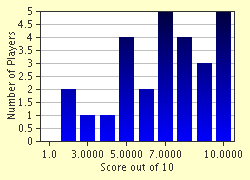Quiz Answer Key and Fun Facts
1. In Acts 6, in response to concerns about the distribution of food to widows, seven men are consecrated to see to practical matters of life, freeing up the apostles to concentrate on "prayer and the ministry of the word." Which of these seven "deacons" is specifically described as "full of faith and of the Holy Spirit"?
2. When Stephen is brought before the Sanhedrin, the religious court at the Jerusalem Temple, and is accused of "speaking against this holy place and the law", he defends himself by reminding them of the lives of their ancestors, beginning with what man of faith who became the father of Isaac through God's promise?
3. In Acts 7, Stephen says that the knowledge of what life or death event caused Moses to flee from Egypt?
4. When Stephen ends his defense by declaring that God dwells in a temple not made by hands, that his accusers murdered Jesus just as their ancestors killed the prophets, and that he can see the "Son of Man" (Jesus) in heaven at the right hand of God, what is their reaction?
5. In the foreground of the painting of Stephen's death by Bartholomeus Breenbergh, a young man is shown sitting with the cloaks of the witnesses of the execution. According to Acts 7:58, what is the name of this man?
6. In Acts 8, Philip, one of the seven deacons, preaches and heals through the power of the Holy Spirit, bringing renewed life to the people of Samaria. When Simon the Sorcerer offers to pay money to gain the power of the Holy Spirit, what does Peter say to him?
7. In Acts 8, Philip is told by an angel to go to the desert road leading from Jerusalem to Gaza, where Philip explains to an Ethiopian eunuch a passage from Isaiah that the African man is reading as he rides in a chariot. After hearing "the good news about Jesus", what act symbolic of death, burial, and resurrection does the Ethiopian ask Philip to perform?
8. Acts 9:1-9 states that Saul, with murder in his heart toward followers of Jesus, was struck deaf on the way to Damascus and fell off his horse, unable to move or speak, lying on the road as if dead for three days and three nights.
9. After Saul's experience on the road to Damascus, he became a persuasive advocate for Jesus Christ, placing his life in such danger he had to escape the city. Because the gates of Damascus were being watched by his enemies, how did Saul get past the walls of the city?
10. As Acts 9 comes to a close, Peter tells a paralyzed man named Aeneas, "Jesus Christ heals you. Get up and take care of your mat." What does Peter do next, when called to a nearby town because a generous woman named Tabitha (or Dorcas) has died? (The image may be misleading.)
Source: Author
nannywoo
This quiz was reviewed by FunTrivia editor
looney_tunes before going online.
Any errors found in FunTrivia content are routinely corrected through our feedback system.

